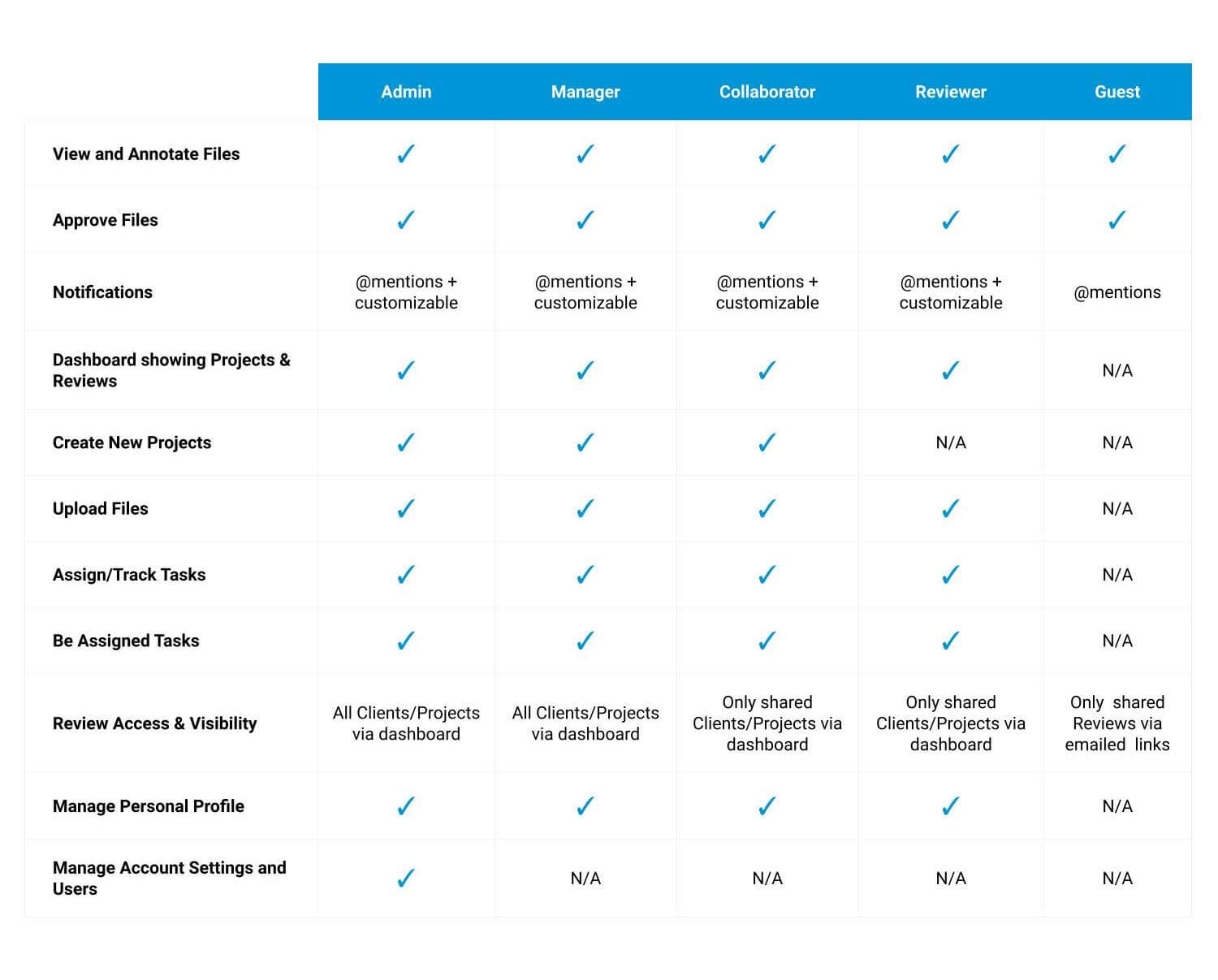Deciding which plan you need on ReviewStudio often boils down to the kind of users you will have engaged in your projects.
ReviewStudio gives you control to define users by roles that can securely and privately access your content.
To provide you with flexibility, we’ve defined user roles that establish the functionality and permission levels that each of your users can have. The roles have been designed to reflect how your creative projects are generally structured.
Understanding User Roles
In ReviewStudio we built user roles to reflect your typical organizational needs.
Typically on a project, you’ll have 4 general roles for content and online proofing workflows;
- Project or production manager,
- Creative team,
- Managers or directors,
- Client or executive teams.
The 5 user profiles we’ve created in ReviewStudio reflect typical project roles.
Admin
Admins have full visibility and control over all the clients and project reviews managed through the platform. They also have access to the account settings to manage users, configuration options, and subscription management.
Manager
Managers are very similar to Admins; except they don’t have access to certain account settings. Managers can access and manage all Reviews, add users to Reviews, create new clients and projects and more. What they can’t do is modify the account configuration settings, create new users, and manage billing.
Collaborator
Collaborators have visibility into projects and reviews that they either create themselves or that have been explicitly shared with them. Collaborators can initiate new projects and reviews and upload files to them – for clients they are already working on (or have been added to by an Admin or Manager). This role is generally appropriate for staff on the creative and production teams.
Reviewer
Reviewers can only access projects and reviews that they are explicitly invited to. Unlike Collaborators they cannot initiate new reviews but they can upload files when needed to the specific reviews that they participate in. This role would be appropriate for people internal or external to your organization who are primarily responsible for reviewing and approving content being developed on an ongoing basis.
Guest
Guest access is an easy and convenient way to share individual reviews since you do not have to set up any user account in advance for them. Guests are only able to access specific reviews they are invited to through the link provided in a Review notification. When you share the link with guests, they will be asked to provide their email and name on their first visit. Requiring a guest password is optional though if you set one, you will have to make your guests aware of it in advance.
Guest access is appropriate for people internal or external to your organization who are only occasionally involved in providing feedback and approvals or when you want to allow extended review sharing and you don’t know in advance who will be involved. Like Reviewers, Guests can provide feedback and approvals (as an option). A key difference is that they don’t have accounts or dashboards to track multiple reviews or projects.

The key functional differences between user roles are shown in the chart below:
Reviewers or Guests for Clients?
Internally, whether a user should be a Reviewer or a Collaborator will be based on whether they are initiating reviews. That’s generally a straightforward decision.
With clients, it’s a slightly different decision. Some ReviewStudio customers invite their clients as guests while others find it advantageous to set up a user account for a client (usually with the role of “Reviewer”).
The reasons to set a client up as a user include:
- When a client is involved in multiple reviews at one time it is more convenient for them to have access to a dashboard so they can easily see and access all their reviews from one place.
- Allowing guest access for a review also lets you set the option if you want your guests to provide file approvals. Since guests are not always known in advance – you are possibly sharing a link – guest approvals only allow for ALL guests to approve or NO guests should approve. If your client has a situation where they would like to share the review with other participants in their organization and those other participants are not approvers, you’d want to create a user account for the key client approver while allowing guest access for all the non-approvers. With user accounts you can be specific about which individuals should be approvers on a review-by-review basis.
- Organizations and agencies with strict security protocols may take issue with the fact that guests who access a review are not authenticated. Even though you may set and require a guest password for access, anyone who obtains that password would be able to access a review using any identity they want. User accounts, on the other hand, are set up in advance by an admin so their identity is verified in advance.
If you prefer to create a user account for a client, keep in mind that it would only be required while the client is actively engaged in a project. You can then delete the user to free up a licence for another user or different client. Deleting a user in ReviewStudio is basically the same as deactivating them – it will not delete any of the files or comments that they may have contributed while they were active
Why Do User Roles Matter?
Keeping User hygiene is important.
Any good feedback process requires roles and responsibilities. Managing your user roles properly in ReviewStudio will help keep your projects running smoothly. And keep in mind that we can always to any plan for you any time you have the need.
You can check out our plans to see how many users are included in each of them.






